Rick Bailey's Blog: Stuff happens, then you write about it, page 7
August 7, 2024
I’ll Take It
August 2, 2024
Getting Close to Publication Date
July 3, 2024
Leftovers
June 23, 2024
A reader said
June 20, 2024
A review of Drop and Add
June 3, 2024
Fava Fave
May 25, 2024
Photo Op

A thousand bears. It sounds like the title of a movie or a broadway musical. Nathan Lane would make a great comic bear. A thousand bears is actually the estimated number of bears in Yellowstone National Park. They warn you at the ranger station. The bears are awake. They’re hungry. A mama was spotted the other day, park ranger says. Do they just say this to get your attention? If so, it works. They ask: Got bear spray? Make noise when you walk. A few years ago a guy at a hotel in Butte told us don’t worry about bears, just wave your arms and they run away. It’s the moose you need to worry about. Mother moose—I wish there was a real plural—mother mooses (meese?) will get in your face. Or more accurately, ON your face. And in point of fact, the three days we were in Yellowstone, an 80-year-old man in Alaska was killed by a mother moose. He just wanted to take her picture–with her two calves.
Yes, we have bear spray. We keep it in the car. Even when we’re on the trail, it’s safe in the car. Because I forget. And because anyway we try to stay on the very populated trails, the noisy ones, like the one down to the lower falls observation deck which is a main thoroughfare for 3-4 school busloads of noisy children. You can imagine serious bears (I guess I should say bear for plural) rolling their eyes and backtracking to the wilderness.) But we deviate now and then, Tizi and I. Let’s go down there—somewhere nobody is. And once we’re down there, we are by ourselves. Just us and nature. In the canyon area of the park, we start down a trail toward Inspiration Point. We see a few hikers, two old guys—I mean older than us—who share a pair of hiking poles. The taller, slightly more decrepit one holds up his pole and shrugs. I got this, he says. As if that’s protection. I tell Tizi, all this reminds me of one of our grandsons talking about sharks, a scary predator on par with bears, and what he would do if he encountered one. I tell him about my friend Dan Leman, who said, when we were 9 or 10, that if a shark comes after you, just punch him in the nose. Grandson likes this advice, though I think he also recognizes it lunacy.
There are degrees of lunacy. Leaving your spray in the car.
The day we were in the canyons, the day before we were going to transition to Grand Teton park, a hiker was mauled by a grizzly over there. Along the trail he encountered two of them, and one of them acted out. If it happens once, it can happen twice. What are they odds?
You think about risk. If you really think about it, you ask, What are the odds? One of the rangers tells us the park is 2.2 million square miles. Really, what are the odds of running into a bear? A thousand bears, all that room for them.
We see a grizzly by the side of the road, with two cubs that must be a year old. She has them on a long leash. They’re doing their thing. She’s far enough way, all of us are out our cars, shooting shooting shooting. She is oblivious. Maybe she likes the attention from the paparazzi. Same day, cars are stopped again. (This stoppage is a Yellowstone thing.) You know it’s something, probably more bison who hog the road, lumber past your car and act like you’re not there. This time it’s a black bear and a cub, way far away, way way way far, and all of us are out our cars, shooting shooting shooting. Same day, in the north edge of the park, we happen upon a moose. It’s a he. A small male, with his antlers coming in. They’re furry. He’s so close I would reach out and touch the velvet on those antlers. I put my window down and take pictures. I question the window-down decision. He ignores us, as a good beast should.
I find our bear spray and put it where I can see it. It comes in a little holster you hang on your belt. I should practice drawing in our hotel room, fix my city-slicker hiking hat at a menacing angle on my head, look in the mirror and draw, baby, draw. You’re only going to get one shot (or bite, as it were) so you better make it count. The bottle has a clip on it, which complicates the draw. So bring it, quit fantasizing about unlikely violent death.

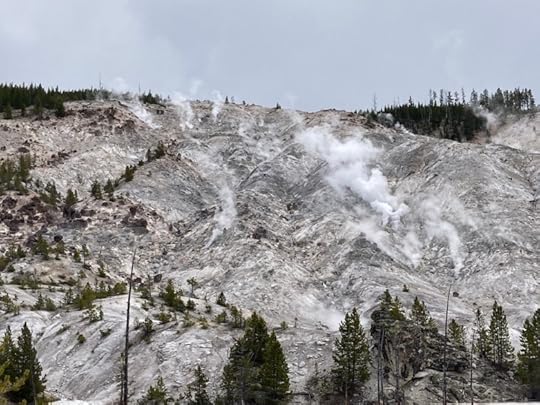


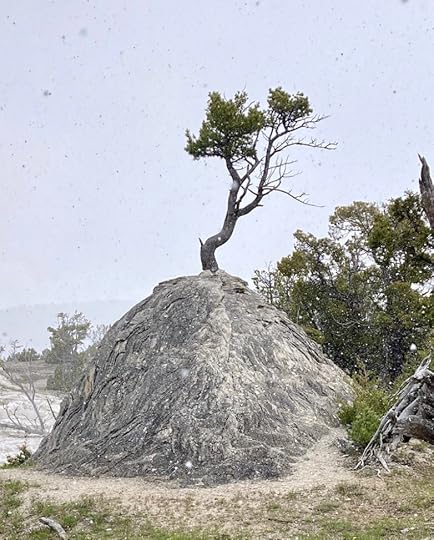
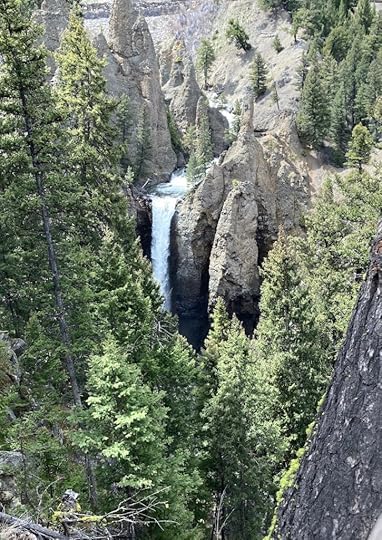
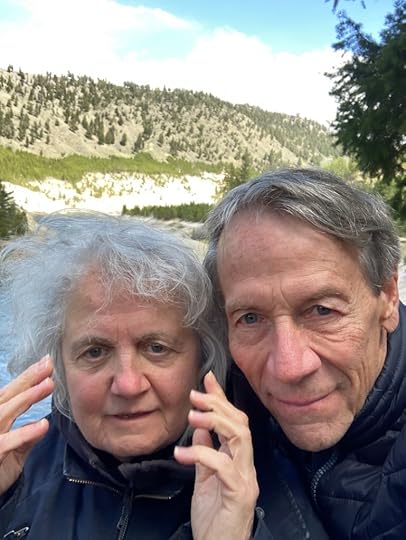
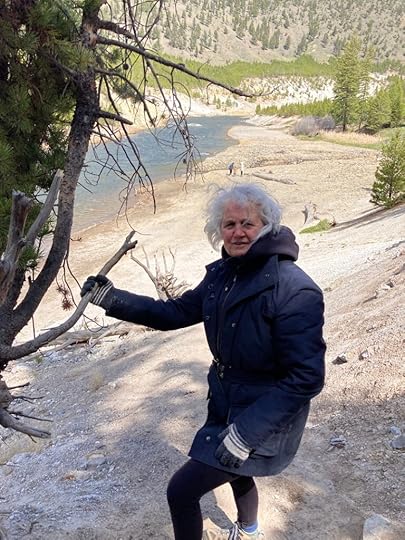

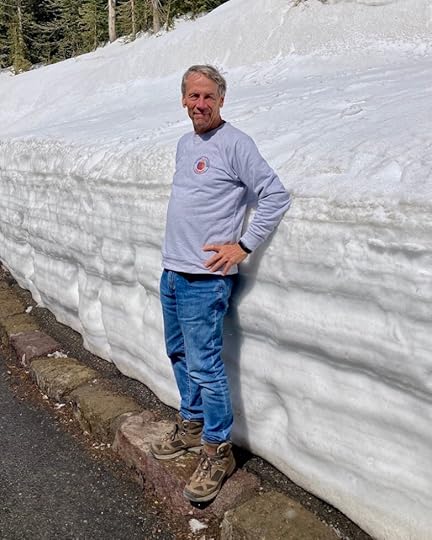
In June of 1971 Steve Eaton and I drove out the Breckenridge, Colorado, in his snazzy new Ford Mustang. Bob Webster, Dan Leman, and Ron Fritz were there waiting for us. We drove straight through, taking turns in the driver’s seat, listening on headsets (why, I don’t know) to Emerson, Lake, and Palmer cranked high, smoking joints on regular intervals, waiting to see the mountains. It must have been along I-76, speeding toward Denver, that they came into view. It was daybreak. We were bleary and no longer high, dulled and sleepless, but seeing the mountains in the distance, we probably drove a little faster, through Denver and over Loveland Pass, cruising down into the valley and taking a left at Frisco. “Frisco,” the name smacked of the West. We had arrived.
Over the next 2-3 weeks I took pictures with a Kodak Instamatic camera, 24 exposure per roll, 3 rolls total. I had never seen a mountain. Back in Michigan I had been to the Porcupine Mountains, which seemed more like hills than mountains. Yes, there was rock visible in places, but not peaks. In Breckenridge we were at around 9500 feet. One Saturday for kicks the lot of us climbed one of the 14,000 peaks (there are 58 of them), Mt. Quandary. I may have shot some pictures. If I did they are lost. If I did, it probably didn’t occur to me to photograph my friends, smiling, gasping for breath, higher than we had ever been. I took pictures of the mountains.
When I got home and had the film developed, the images were a letdown. There was a mountain, there was another mountain, and another and another and another, looking all more or less alike. The pictures didn’t capture the grandeur.
Today we are back in Michigan, home from Yellowstone. We took a lot of pictures. In the digital age, because the cost of developing them is no longer an issue, we take pictures with abandon. We took multiples shots, sometimes three, four, or five pictures of the same cliff, the same waterfall. Typically when we travel, my morning-after routine involves deleting photos from my phone. Someone said one time, back in the age of cameras with film in them, shoot three rolls of film and maybe you’ll find one really good one. That one image is precious. From 1974 I have a photograph of the bridge in Big Sur, enlarged, framed. And a photo of small waterwheel and mill in Canterbury, England, also in 1974, also enlarged and framed. Photos taken with that Instamatic.
Back from Yellowstone’s Grand Canyon, here’s a few images (we don’t say pictures much anymore). It was really beautiful. Really. Beautiful.
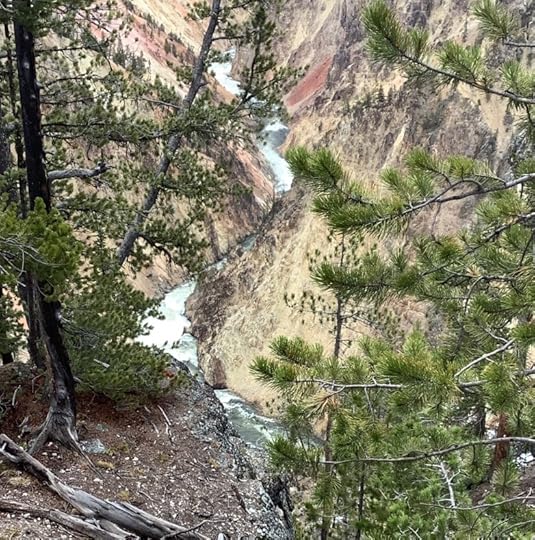
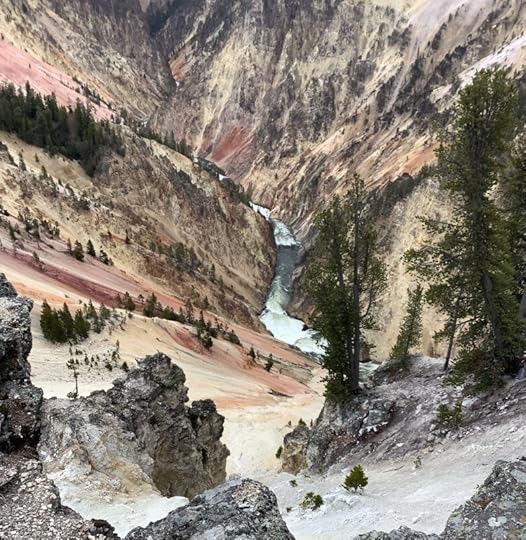
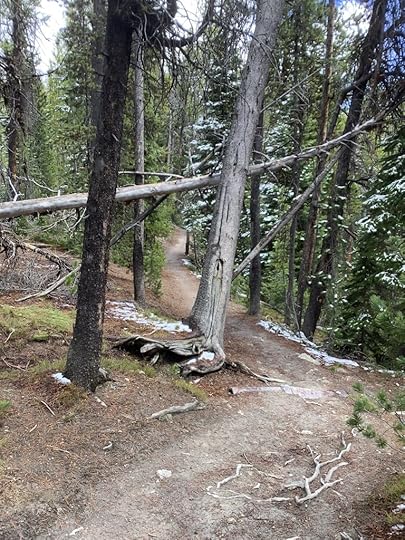
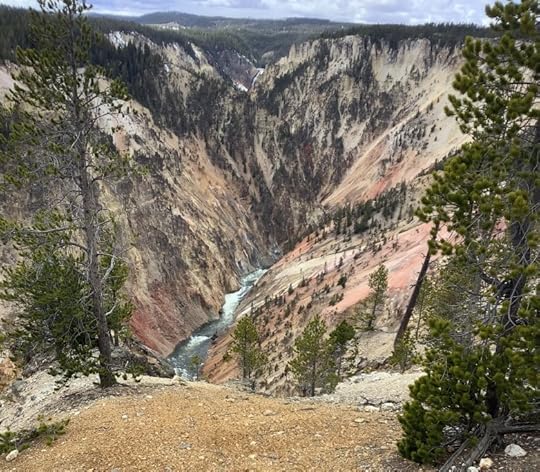
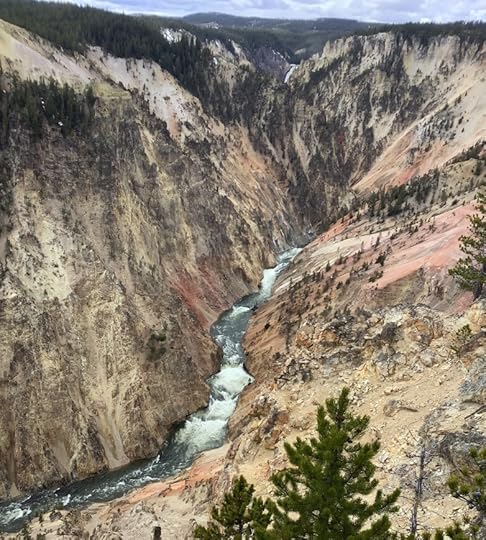
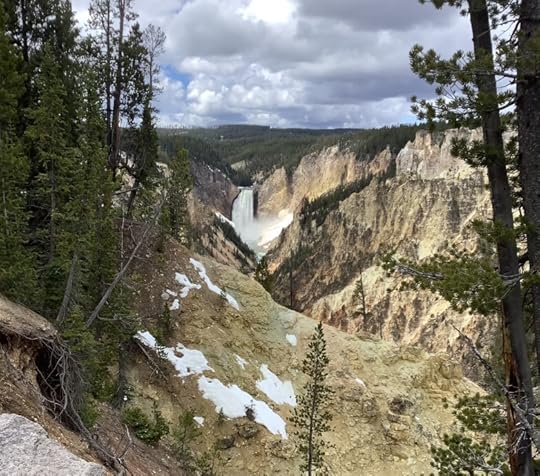
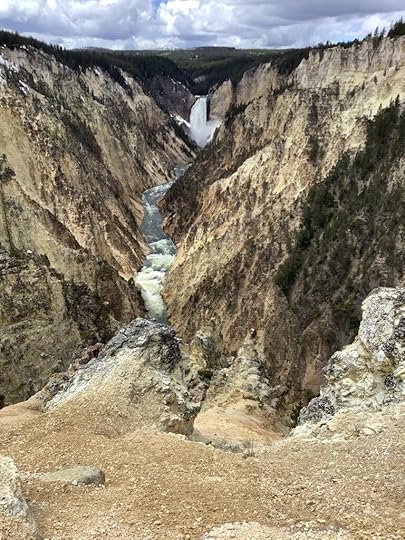
May 12, 2024
Have a Seat

It is an inconvenient truth that the ding comes when you least expect it and when you least want it. In this case, two dings. We’re driving down I-70, our second day on the road, expecting to arrive in Denver by late afternoon. It’s sunny and windy. It’s desert. It’s a divided road, two lanes in each direction. In the right lane, patches of old road repair on regular intervals growl under the car. I’m driving 82 mph in the left lane to avoid the growl. We’ve been arguing on and off since Gretna, Nebraska, both of us right, both of us wrong, I’m more wrong than she is, and I don’t mind admitting it if it means we can just stop. This is where the ding comes in.
First ding is more flash than ding. The fuel light, a tiny spot of red in the lowest region of the gauge.
“Mother f-,” I say.
“What?”
“We should have gassed up a long time ago.”
“How bad?”
“Bad,” I say. “Fumes.” Maybe it’s only the remote idea of fumes left in the tank, fumes of fumes; metafumes.
Then another: Ding. This one’s me. “And I really have to pee.”
“Why didn’t you stop?”
“Why didn’t we stop.”
“Is there a town?”
“Let’s hope so.”
We need to get there fast, wherever there is a there. But if I go faster, do I consume more fuel? I tap the brake to uncruise from 82, and we coast and slow to 60 mph. That seems terrible. Now we’re getting there, if we get there, even slower.
I would have a sign.
And we get one: Merino, 7 miles.
“Is there gas there?” Tizi says.
“I really have to pee.”
These are the exigencies of road miles: Fuel and food and rest. We’ve been arguing about, among other things, the pros and cons of driving vs flying to California to visit our son, his wife, and their new baby. Four days of travel vs one day. Three nights in our own bed vs. three nights in a hotel. What we see–heartland, fields, mountains, desert–vs what we don’t see. On the interstate, and off, we steel ourselves to the reality of bad food, fast bad food, slow bad food, most of it dreary, forgettable, and, with a little luck, avoidable. The night before, in our Des Moines hotel room I searched for restaurants in the area, key word healthy, and there it was, a possibility, called Protein House.
“How about Protein House?” I said to Tizi.
“I’m really not that hungry.”
“We haven’t eaten since breakfast.”
“We had hazel nuts.”
“Hazel nuts and water,” I said. “They’ve got bowls at Protein House.”
The weather was looking ugly. The day before tornadoes had torn through Oklahoma, Nebraska, and Iowa. And here we were in Iowa. And the sky was dark before dark. It looked badly bruised, and it was coming for us.
Protein House is next to a Life Time Fitness. It has seating for 50-70 people. It’s totally empty. While we scan the menu a guy comes in to pick up an order. A few minutes later an emaciated youth with straggly brown hair comes in for a health drink. A few minutes after that a muscular dad and his kid, likely from Life Time, come in for take-out. Outside the weather is landing on us. Shrubs visible through the windows are tossed in all directions. The building we’re in is all windows and steel and cement. Don’t stand near windows, I think. How to avoid injury in a tornado. Maybe go to the men’s room? Both of us?
I order the quinoa bowl, called Thai Monster, with vegetables, chicken, beef, and peanut sauce. Tizi orders The Plant Power Bowl, then alters it beyond all recognition, then changes her mind and asks for that guy’s health drink. The quinoa makes me feel good, the idea of it. The chicken and beef call for aggressive chewing. Tizi is happy with her drink. The storm passes through Des Moines on its way to Kalamazoo.
The average person lets water 4-7 times a day. The average time it takes is 20 seconds. There’s actually something in urination literature called the 20 second bladder rule.
I take the Merino exit. Where’s the town? There’s no Merino. At least not there. A wind battered sign indicates Merino is seven miles down a two-lane pot-holey road. The sign should also say: And Good Luck.
“Where’s gas?” Tizi says
I point where that road goes. “Down there maybe.” Where it goes I can’t see.
“Is there gas down there?”
“I don’t know, but I really have to pee.”
In Italy it is common to see men standing by the side of the road relieving themselves. They cozy up to a guard rail, they lean toward the cement wall supporting an overpass, they do their business. In the US, it seems less frequent, more of an emergency protocol. This is definitely that. I get out of the car and walk around the back, sidle up in the direction of the passenger door for privacy. As I do, a truck passes us, on its way to Merino. He has a clear view and I don’t care. The relief takes a while. I’ve been sitting on my prostate for 350 miles. And I discover that I’ve parked the car on a slightly wrong-way incline. The puddle forming on the dirt shoulder is flowing back in my direction. I check Tizi’s mirror to see if she’s watching, then take a step toward the rear of the car. The puddle, a little bigger now, follows in my footstep. It’s windy. If I want to stay dry, my turn options are limited. Three more sidesteps, I’m still not quite done. I check the mirror again. If she sees this . . .
The average person lets water 4-7 times a day. The average time it takes is 20 seconds. There’s actually something in urination literature called the 20 second bladder rule. Good grief, and I bet I’ve passed the one minute mark and sidestepped a total of five times to keep my feet dry.
Back in the car, I’m relieved that my private moment by the side of the road goes unremarked. I search gas on Google Maps.
“Atwood,” I say.
“Where’s that?”
“Back.”
“How far?”
I look at the gas gauge. “Seven miles.”
She is quiet. So quiet.
We head back to the east, across the desolate Colorado desert on I-76. A sign by the side of the road warns of high wind, stating the obvious. At 55 mph, those seven miles feel like fifty. I’m worried at the exit we’ll have to take a long ride into nothingness to find Atwood and its gas station, but there it is. Exit, at the bottom of it turn left, under the overpass, then the friendly Sinclair station is right there on the left.
While we wait for our food I congratulate the guy in the corner of the restaurant for his handlebar mustache.
A couple days later, looking for a late breakfast, we are tempted but pass on Peggy Sue’s diner in Yermo, California. We stop in Barstow, where we find Roy’s Cafe.
In search of breakfast, from I-15 South, where I gas up (even though I still have all of a quarter tank of gas), I drive five minutes down Barstow Road to Main Street, which we discover is Route 66. Where Barstow Road deadends at Route 66, there’s Roy’s Cafe, a joint that Jack Kerouac would have driven past, an all-American diner with posters of Marilyn Monroe and Marlon Brando and servers who speak Spanish to each other and hand us a Mexican inflected menu. Tizi orders the spinach omelet, I get the muchado because I like the word and the picture on the laminated menu.
While we wait for our food I congratulate the guy in the corner of the restaurant for his handlebar mustache. I swap glances and smiles with the Mexican grandma sitting by herself in the next booth eating ham and eggs and talking Spanish on her cell phone. I step outside to take pictures of the parking lot murals, 19th century icons–Fred Harvey, dining room and boarding house entrepreneur, and William Barstow himself, president of the Topeka and Santa Fe Railroad.
The food is good. We talk about what we’ve seen in the past three days: the rivers (Mississippi, Platte, Nishnabotna, Colorado, Green, Sevier, Virgin), the mountains east of St. George, the snow above Denver, the plowed fields in Iowa and Nebraska ready for planting, the desert we just crossed and the Joshua trees. There’s a lot to remember.
At the Atwood Sinclair station, there was a signature green dinosaur out front, a big guy. While the gas pumped I thought it would be nice to get a picture of Tizi with the Sinclair dinosaur. The kids would enjoy it. I would enjoy it. I was pretty sure she wasn’t in the mood. I was pretty sure she would never be in the mood. And that was okay.
Now she had her omelet and I had my muchado. We were in a historic place, having an American moment. And we were fine.
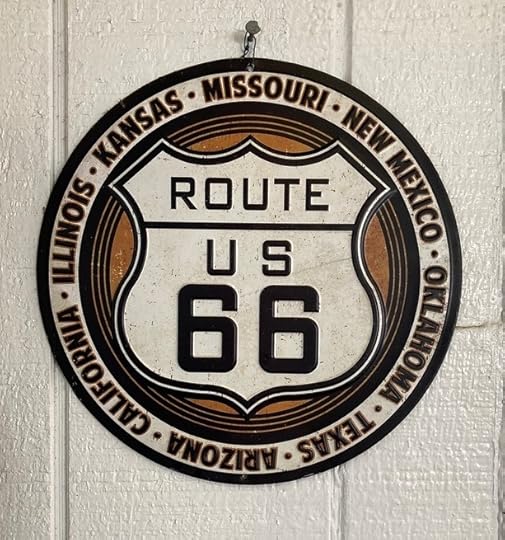
May 5, 2024
That Time of Year

We’re looking for him. We find 130 Michael Smiths.
I’m standing at the kitchen counter chopping an onion at eleven in the morning. We’ve just walked seven miles, on what feels like the first day of spring. Real spring: The sky is blue, the maples are in lush full leaf, the ferns along the east side of our house are burgeoning. The birds are so noisy even with these bad ears of mine I can hear them. Ten minutes into our walk I pull off one of my two layers, the long sleeve shirt.
“That’s a lot of Michael Smiths,” I say now. Tizi is looking for him on her IPad.
And I’m thinking, there could be a joke– How many Michael Smiths does it take to…? But it’s 130 obituaries. An obituary is not funny.
Earlier today, on our walk to the top of Van Ness, an avenue of maples near our house, we stopped and talked to Carol, a friend from the local senior center, which we abandoned during the plague, then never went back to, post-Covid.
“Will you look at us,” she says to Tizi, pointing first at her own hair, then at Tizi’s. Both gorgeous silver. Carol is sleek and energetic and funny. This morning she’s dressed in slim jeans, a gray fleece, and running shoes. When we walk up her driveway she’s stabbing a weeding fork into dandelions along her front sidewalk. She says her house is too big. She’s lived here, post divorce, thirty some years. Too many flower beds, she says. Too much work. When I ask, she says her hip replacements were a great success. Yes, she tells Tizi, she did go back to the senior center, where there are some of the same people. And there are those, like us, who never came back. And there are some new seniors too. I think: Does that make us old seniors?
“What about Ed?” Tizi asks.
I know she’s afraid to ask. Ed the trumpet player. Ed the leader of the senior center big band. Occasionally he took the elevator downstairs to the exercise machines and didn’t exercise. Mostly he sat at the round table upstairs, drank coffee, and dispensed witticisms. A few years ago we missed his 90th birthday bash. He had a yellow Corvette in the parking, but didn’t drive much. One Tuesday night I took him (or he took me) to a jazz jam session over on Woodward Avenue. We sat through two sets. Every so often, he wiped tears from his eyes. He drank one glass of beer.
“Gone,” Carol says now.
Tizi shakes her head. “I knew it.”
Carol says, well, Ed was 92. “But Michael Smith?”
He was a young senior, with a shock of very premature gray hair and a wicked sense of humor. He had no business being a senior. And now, he has no business being dead.

Like Carol I think about the flower beds. And the basement. And a spare room upstairs. Every house has a junk drawer. We have a junk room. At our age you begin to reckon with the too-muchness of a house. At least I do. Tizi not so much.
Part of the problem is accidental shopping. We try to avoid Home Goods. There’s one right next to Costco. If you’re waiting for Costco to open you can kill time at Home Goods. But there’s peril. We don’t need another pan, another serving dish. We have enough tongs. When I open kitchen and bathroom and mudroom cupboards, I find soaps we bought at Home Goods and forgot about.
I find soaps with a French accent–savon pour les mains (soothing, it says on the label, soft cotton), three 17 ounce pump bottles of those; Lemon Verbena made by or for aromatherapy rituals; Ginger Mandarin Hand Soap, which is pure and good, biodegradable and plant-based; a Rain Forest Collection of Ecological Products (meaning, judging from the look of them, soaps); we have Thyme Vegetal Soap and Cedar Vegetal Soap; Kirk’s Original Coco Castile pure botanical coconut oil 100% natural hypoallergenic skin care with no synthetic detergents soap; we have The Chef’s Soap (not A chef’s soap) also made in France. All that soap makes me want to get dirty. It also tells me don’t buy any more soap, maybe ever.
Online shopping has exacerbated the problem. It’s too easy to buy stuff.
A helpful message popped up on my phone one day. I’m paying too much for hearing aids was the message. That day, it just so happened, I came home from Shake Shack,a stressful outing with a grandson involving touch screen menus and digital ordering and a flood of hungry young professionals, and I was missing one of my hearing aids. I tried calling. Did you find a small electrical thingie on the floor… and learned if you press 1 you can place your order and if you press 2 you can leave a message for the manager but really you really can’t. They don’t ever say wait for the beep. There’s no beep. I pictured Big Beaver lunch traffic passing through Shake Shack, my dinky, obscenely expensive device under foot, smashed.
This ad said, “Get new hearing aids for less than $100!”
The operating instructions, a 12-page manual only slightly larger than a postage stamp, said it can take up to two weeks to get used to them. I lasted three days. The problem was feedback, annoying high-pitched squealing coming from the direction of my head. I could hear the feedback just fine. The frequency-adjusted audible world that came to me sounded like sharpened knives. Tizi said, “What’s that noise???” She meant the feedback. The one-button control panel on the side of these things, which are the size of a peanut inserted into your ears, is no bigger than the head of a pin. Press the head of the pin three times to adjust volume. Squeal. Hold the head of the pin down for three seconds to change the mode. Squeal.
When my father got old and wore hearing aids, his fingers were always in his ears, adjusting, pressing, fiddling, which I think now, in my case, is only slightly less unsightly than a finger up my nose. No one wants to see that. I am becoming my father. Deaf, like him. Old.
I sent them back.

Poor Michael Smith. We never find the obit. Nor the death notice
Next day I’m thinking about him again, walking out of a local market, and I see Ted. I’d see him at the senior center, too, but we go back a number of years. We go way back to BC (before Covid) years, to the years our kids were in school together. He is heavier. He has unkempt gray hair and an unruly goatee.
He squints as we pass each other in the parking lot. “I know you,” he says.
“Ted,” I say.
“What’s your name?”
The look of irrecogntion is there. I tell him my name, feeling a shiver of alarm. He says, “How do I know you? Do you go up North?”
I say yes, we go up North. I tell him we’ve been to his house up there. This doesn’t register. He’s trying to puzzle it out. I can see he’s tired of puzzles. “We sat all those nights by the Herman’s pool?”
“The Hermans,” he says. He gets that. Then: “Whatever happened to them?”
I feel a moment of panic of my own when I can’t remember his wife’s name. I ask, Grandchildren? Yes, he has two.
“We’ve got three,” I say. “We’re going to California on Tuesday to see the new one.”
He asks again, “Do you go up north?” If he knows me I can’t tell. He has other things not on his mind.
When I get home I tell Tizi. She says she surprised Ellen lets him drive.
Ellen, I think. That’s right.
Before lunch I step outside to walk around the house, to feel the spring air again, to stand in the sun. In Tizi’s patch of trillium we have a lump of rock that’s a foot tall and comes to kind of a point on top. Every year on a day like today we’re likely to see a chipmunk perched on top of it, looking around in its nervous, jerky chipmunk manner. This is one of those days. It’s the first chipmunk day of the year. I can’t hear it chipping and chattering, but I know it does that. What I do hear is a sound in the distance. At first I think: electric bicycle, the distinct whine as it picks up speed, probably just down the street. Then I realize, no, it’s a motorcycle accelerating, running through the gears in the far distance, going who knows where, fast, and enjoying it.

April 11, 2024
Drink Up

Years back a pipe burst in our apartment bathroom in San Marino. Three thousand miles away, we got the news: a trickle of water had found its way into Mr. and Mrs. Riccardi’s apartment below ours and continued to flow until the water to our unit was shut off completely. Repairs would be needed. It was an opportunity. Fix the leak, yes, and why not re-do the bathroom? That’s what we did.
Of course all that meant a lot of work: demolition, by a worker they call a “muratore,” a wall (and floor) man conversant with cement; then plumbing, tile, electrical, and carpentry work. It took weeks, procuring materials, scheduling the work, being there and not there (you couldn’t live in an apartment with no running water). Since then I’ve thought of those ads you see in travel magazines: buy an apartment in Italy for a dollar or a euro. How easy it sounds. What about restoration? I lived through that process on a small scale. It was not easy.
The job required my living for a few weeks ala agriturismo, in a bed and board place ten minutes from the apartment. Board was dinner every night, lots of good grub. And lots of good wine. On one end of the dining room was a wall with ceramic pitchers hung on pegs. And two spigots, one for sangiovese, one for cabernet. You grabbed a pitcher, filled it, and went to your table. The wine tasted great. At the agritour, they were like, Have all you want. We’ll make more. It was quaffing wine, slurping wine, uncomplicated, great with food. The grapes were grown in vineyards just outside the door. This, I realized, was vino sfuso. Wine from the barrel. I’d been enjoying it for years. Now I knew what it was.
I thought of vino sfuso recently–correction, I think of vino sfuso all the time–just back from our most recent stay over there. We drive and eat all over the Marecchia Valley and the low Apennine hills when we’re in San Marino. Much of the arable land is given over to olive groves and vineyards. Wine production is bread and butter, both a significant part of the local economy and a quality-of-life factor in the home.
It was quaffing wine, slurping wine, uncomplicated, great with food. The grapes were grown in vineyards just outside the door.
In restaurants, the trattoria and osteria there and all over Italy, house wine is often vino sfuso. You order by the glass, by the quarter- and half-liter, or by the liter. It’s cheap and dry and, significantly, lower in alcohol content than bottled wine. It’s also lower in alcohol content than American wine. You notice the difference. For a decade I took people to Italy on 7-10 day excursions focused on local culture and what I called “heroic eating.” On the part of a few travelers on every trip, there was also some heroic drinking involved. Every morning at breakfast, a reveler would testify, “I drank all that wine last night and I’m not hung over.” Wasn’t that great?
It is great, as close as you can get to no-fault wine.
In Rimini, whose backstreets we frequently walk and drive, you’ll see signs in storefronts: Vino Sfuso. Stop in with your bottles and jugs. Fill ‘er up. That’s been the story for hundreds of years over there. According to the news magazine The Florentine, as far back as the 15th century, surplus wine in Italy has been a problem and a boon, depending on your point of view. There’s simply so much wine. So. Much. Wine. Produced by land-owning families, who would keep the best of the wine for themselves, when the tanks ran over, the spillage, the excess wine was sold off in the cities, where common folk could buy it at bargain basement prices at “wine windows.” Today in Florence, near Piazza della Signoria, you can belly up to the bar at Fratellini, one of those “wine windows,” and enjoy a glass of wine on your feet, the way, for hundreds of years, residents would pass by with their jugs for a refill.
In the US, as far as I know, vino sfuso is not a thing. In the summer of 2010 we went on a vineyard crawl in California with friends. We tasted a lot of the good stuff. When we took a break for lunch, I wondered what we would find in restaurants. Local wine, for sure. At reduced prices? (After all, it was made two miles away.) No reduced prices. No house wine. No vino sfuso.
Home from Italy now for two weeks, I am nostalgic for that simple pleasure. In the US, wine is not cheap. (In San Marino I pay 5 euros at the grocery store for a bottle of sangiovese I find totally satisfying.) And in the US, to satisfy the American consumer who likes the complexity and clout of a big red wine, the average alcohol content approaches 14 percent. Many wines exceed that level. Thinking vino sfuso, at Costco recently I looked at inexpensive American reds, checking price, checking ABV. Nothing below 13.5 percent. Then I remembered–the box. Kirkland’s three-liter box of cabernet sauvignon. Inside the box, a plastic bag. Wine in a bag in a box. On the side of the box, a tap. The box wine was on a pallet around the corner from the bottled stuff, over there next to car batteries and folding chairs.
I looked: ABV was 13 percent.
Hello.
Could I get any closer to vino sfuso? I couldn’t see how.
I bought a box of it, recalling, when I did, my father-in-law’s cellar, which I occasionally visited after Tizi and I got married, seeing the cases of gallon-jug wines he bought and decanted, CK Mondavi, Fortissimo, Cribari, wines he poured at the table and cut with water, as Italians are inclined to do. At that point I was a graduate of the university of Boone’s Farm. I had known the fruity bouquet of Ripple Pagan Pink. I found I could love those jugs.
And in the US, to satisfy the American consumer who likes the complexity and clout of a big red wine, the average alcohol content approaches 14 percent. Many wines exceed that level.
Back home from Costco I read up on the box wine I had just bought. And found this blessing, this paean offered by the wine critics at Tasting:
Indigo color. Aromas and flavors of black cherries and vanilla, fresh wet coffee grounds and cocoa nibs, grilled peppers, and crushed violets with a medium-to-full body and a medium-to-long finish revealing accents of grilled black cherries, leather and peppers, five spice, and potting soil. A rock solid Cabernet with great pairing versatility; grab a bottle for the picnic with your friends this weekend.
I opened the box, pinched the tap, and tasted. I noticed color, not indigo, more the color of red wine. I tasted again, thinking I might actually try to count the spices for myself. About that potting soil finish. Really? I missed that.
In 1970 a bottle of Boones Farm cost a dollar. Adjusted for inflation, that bottle of apple or strawberry wine would cost $7.50 today. The box? Three liters, equivalent to four bottles, rings up at less than $3.50 a bottle. That definitely seems like progress.
The wine is more than satisfactory. It’s good. I visit the box down in my dinky cellar space, on a shelf next to the tuna fish and Trader Joe’s cherries. When I cook lunch, between 11:45 and 12 noon, I go downstairs and draw a glass. Walking upstairs, lightly jostling the wine in its glass, I think I detect a bouquet. In Italy I could drink vino sfuso every day, before, with, and after food. In the case of the box, so far I have yet to slurp. In fact, I find I usually do not want a second glass.
When you think about it, that’s probably a good thing.

Stuff happens, then you write about it
- Rick Bailey's profile
- 31 followers



